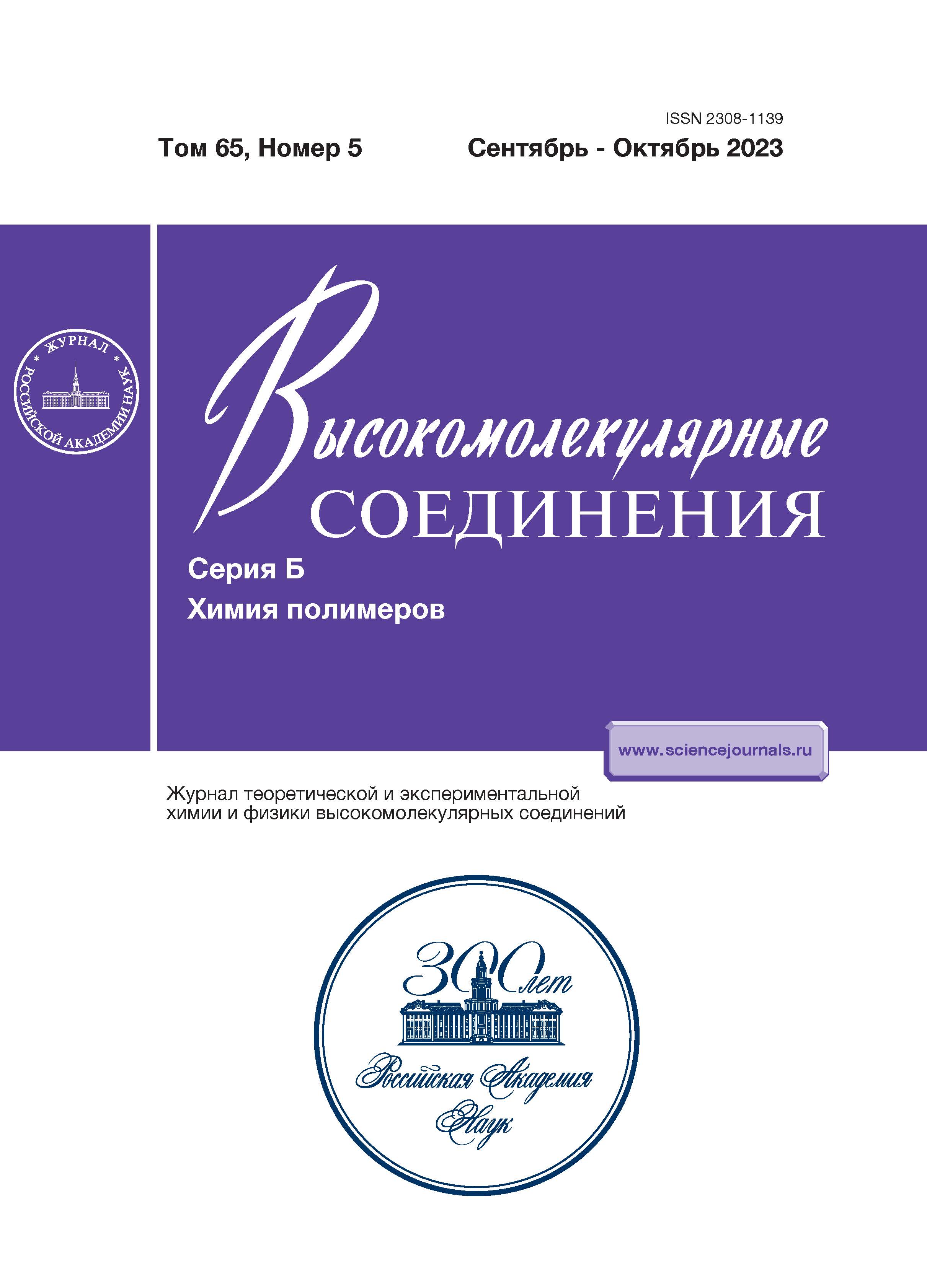ВОЗМОЖНОСТИ ПРИМЕНЕНИЯ ГУАНИДИНСОДЕРЖАЩИХ ОРГАНОМИНЕРАЛЬНЫХ КОМПЛЕКСОВ В КАЧЕСТВЕ БИОЦИДНЫХ ФУНКЦИОНАЛЬНЫХ ДОБАВОК ДЛЯ ВОДНО-ДИСПЕРСИОННЫХ ПОЛИМЕРНЫХ МАТЕРИАЛОВ
- Авторы: Герасин В.А.1,2, Журина М.В.3, Куренков В.В.1, Менделеев Д.И.1, Оченков Д.Е.1,2, Myat K.H.2
-
Учреждения:
- Институт нефтехимического синтеза им. А.В. Топчиева Российской академии наук
- Российский химико-технологический университет имени Д.И. Менделеева
- Институт микробиологии им. С.Н. Виноградского, Федеральный исследовательский центр “Фундаментальные основы биотехнологии” Российской академии наук
- Выпуск: Том 65, № 5 (2023)
- Страницы: 372-383
- Раздел: КОМПОЗИТЫ
- URL: https://cardiosomatics.ru/2308-1139/article/view/650873
- DOI: https://doi.org/10.31857/S2308113923600028
- EDN: https://elibrary.ru/CRDLOZ
- ID: 650873
Цитировать
Полный текст
Аннотация
Исследована возможность применения органоминеральных комплексов полигексаметиленгуанидин гидрохлорида в качестве функциональной добавки для водно-дисперсионной краски на основе поливинилацетата. Получены органоминеральные комплексы с содержанием гуанидинового полимера 20 и 30 мас. %; при этом наблюдалась интеркаляция цепей полигуанидина в межслоевое пространство монтмориллонита. Выявлено, что при введении органоминеральных комплексов в состав дисперсии поливинилацетата стабильность полимерной пленки к воздействию воды сохраняется, тогда как при добавлении свободного полигуанидина водостойкость пленки резко снижается. Существенного влияния органоминеральных комплексов на реологические характеристики дисперсии и ее седиментационную устойчивость не оказано. Испытания водно-дисперсионных красок с различными добавками показали, что при введении в материал органоминеральных комплексов предотвращается обрастание покрытия биопленками грамположительных бактерий Staphylococcus aureus и Rhodococcus erythropolis при сохранении удовлетворительных показателей твердости, водостойкости и паропроницаемости покрытий.
Об авторах
В. А. Герасин
Институт нефтехимического синтеза им. А.В. Топчиева Российской академии наук; Российский химико-технологический университет имени Д.И. Менделеева
Email: gerasin@ips.ac.ru
Россия, 119991, Москва, Ленинский пр., 29; Россия,
125047, Москва, Миусская пл., 9
М. В. Журина
Институт микробиологии им. С.Н. Виноградского, Федеральный исследовательский центр“Фундаментальные основы биотехнологии” Российской академии наук
Email: gerasin@ips.ac.ru
Россия, 117312, Москва, просп. 60-летия Октября, 7, корп. 2
В. В. Куренков
Институт нефтехимического синтеза им. А.В. Топчиева Российской академии наук
Email: gerasin@ips.ac.ru
Россия, 119991, Москва, Ленинский пр., 29
Д. И. Менделеев
Институт нефтехимического синтеза им. А.В. Топчиева Российской академии наук
Email: gerasin@ips.ac.ru
Россия, 119991, Москва, Ленинский пр., 29
Д. Е. Оченков
Институт нефтехимического синтеза им. А.В. Топчиева Российской академии наук; Российский химико-технологический университет имени Д.И. Менделеева
Email: gerasin@ips.ac.ru
Россия, 119991, Москва, Ленинский пр., 29; Россия,
125047, Москва, Миусская пл., 9
K. Htoo Myat
Российский химико-технологический университет имени Д.И. Менделеева
Автор, ответственный за переписку.
Email: gerasin@ips.ac.ru
Россия,
125047, Москва, Миусская пл., 9
Список литературы
- Nichols D. Biocides in Plastics. iSmithers Rapra Publishing. 2005.
- D'Arcy N. // Plast. Add. Comp. 2001. V. 3. № 12. P. 12.
- Jones A. // Plast. Add. Comp. 2009. V. 11. № 4. P. 26.
- Tambe S.P., Jagtap S.D., Chaurasiya A.K., Joshi K.K. // Progr. Organic Coat. 2016. V. 94. P. 49.
- Makal U., Wood L., Ohman D.E., Wynne K.J. // Biomaterials. 2006. V. 27. № 8. P. 1316.
- Giacomucci L., Raddadi N., Soccio M., Lotti N., Fava F. // New Biotechnology. 2019. V. 52. P. 35.
- Kalinina I.G., Gumargalieva K.Z., Semenov S.A. // Protect. Metals Phys. Chem. Surf. 2018. V. 54. № 7. P. 1330.
- Halima N.B. // RSC Advances. 2016. V. 6. № 46. P. 39823.
- Zhurina M.V., Kallistova A.Y., Panyushkina A.E., Gannesen A.V., Mart’yanov S.V., Gerasin V.A., Sivov N.A., Tikhomirov V.A., Plakunov V.K. // Microbiology. 2020. V. 89. P. 396.
- Bondarenko O., Juganson K., Ivask A., Kasemets K., Mortimer M., Kahru A. // Arch. Toxicology. 2013. V. 87. № 7. P. 1181.
- Oule M.K., Azinwi R., Bernier A.M., Kablan T., Maupertuis A.M., Mauler S., Nevry R.K., Dembélé K., Forbes L., Diop L. // J. Medical Microbiol. 2008. V. 57. № 12. P. 1523.
- Park D.U., Park J., Yang K.W., Park J.H., Kwon J.H., Oh H.B. // Molecules. 2020. V. 25. № 14. P. 3301.
- Gerasin V.A., Mendeleev D.I., Kurenkov V.V., Menyashev M.R. // Russ. J. Appl. Chem. 2018. V. 91. P. 1297.
- Holtz R.D., Lima B.A., Souza Filho A.G., Brocchi M., Alves O.L. // Nanomed. Nanotechnol. Biol. Med. 2012. V. 8. № 6. P. 935.
- Amann M., Minge O. // Synth. Biodegrad. Polym. 2011. P. 137.
- Murray H.H. // Appl. Clay Sci. 2000. V. 17. P. 207.
- Sas S., Danko M., Bizovská V., Lang K., Bujdák J. // Appl. Clay Sci. 2017. V. 138. P. 25.
- Gerasin V.A., Kurenkov V.V. Pashkov O.V., Ilyin S.O. // Colloid J. 2017. V. 79. P. 588.
- Куренков В.В., Пашков О.В., Герасин В.А. // Изв. высших учебных заведений. Сер. “Химия и химическая технология”. 2019. Т. 62. № 8. С. 126.
- Plakunov V.K., Mart’yanov S.V., Teteneva N.A., Zhurina M.V. // Microbiology. 2016. V. 85. P. 509.
- Assem Y., Khalaf A.I., Rabia A.M., Yehia A.A., Zidan T.A. // Polym. Bull. 2017. V. 74. P. 3015.
- Choudalakis G., Gotsis A.D. // Eur. Polym. J. 2009. V. 45. № 4. P. 967.
- Langendonk R.F., Neill D.R., Fothergill J.L. // Front. Cellular Infect. Microbiol. 2021. V. 11. P. 665759.
- Ciofu O., Tolker-Nielsen T. // Front. Microbiol. 2019. V. 10. P. 913.
- Hemati S., Kouhsari E., Sadeghifard N., Maleki A., Omidi N., Mahdavi Z., Pakzad I. // New Microb. New Infect. 2020. V. 38. P. 100794.
Дополнительные файлы
















